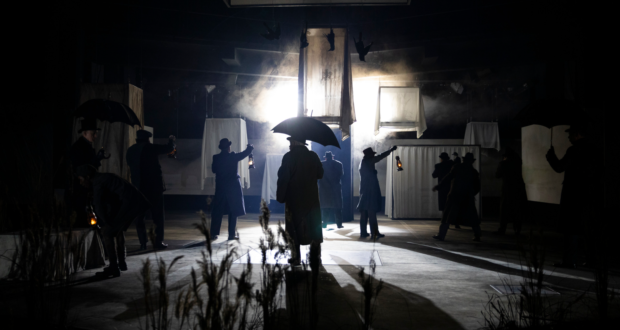A dark but thrilling play about country superstition, power dynamics and artistry, adapted by Kate Mosse from her Gothic novel, and rightly debuting in the Sussex county where the action takes place. Summary
Rating
Excellent
A cluster of taxidermy birds, billowing dresses and stormy weather could be the recipe for a Goth’s ideal summer, but in fact these are all ingredients for a new stage adaptation of brooding historical thriller The Taxidermist’s Daughter, brought to Chichester Festival Theatre by the author herself, Kate Mosse. With the book set in the nearby Fishbourne Marshes, and with Mosse a born and bred local, this play feels rooted in the landscape. A famous former museum inspired her, too: the Museum of Curiosities, a taxidermist’s popular collection that Mosse visited as a child, is reimagined here as the long-closed Gifford’s Museum of Avian Taxidermy. Despite it being 1912, our protagonist, the talented and intuitive Connie Gifford (an impressive Daisy Prosper), is the one making the taxidermy.
As Connie bemoans, “only men with their delicate little hands” are allowed to become taxidermists, not women. She must do her work in secret – firstly, because she’s not a man, but secondly, because her father (Forbes Masson) is unable to do the work himself, torn apart by past guilt and self-soothing with drink. Her artistry blends nicely with frustrated amateur painter Harry (Taheen Modak), also trying to bring life to his work but, unlike Connie and her father, not worried about paying the bills.
Whilst Connie guts dead birds and reassembles them in lifelike scenes, she struggles to reassemble her memories of the past, disturbed by a childhood accident 10 years earlier. Her recollections are as gauzy as the boxes cleverly doubling as museum exhibits, tables or artworks, dotted around the stage by designer Paul Willis. Meanwhile, the fractured events of the past are being brought to light by a mysterious veiled woman, targeting local residents with their own secrets to hide. Of course, there’s blood to be spilt.
The Giffords’ home, Blackthorn House, is on the edge of Fishbourne in many ways – ‘We’re outside of things here,’ says Connie, speaking as much for the family’s societal position as for the geography. Willis’ deliberately sparse design helps illustrate this, with clumps of reeds at the edge of the stage, and a series of screens showing projections of reeds, rain, and storms, echoed by projections on the stage floor itself to amplify the effects. Weather is a pathetic fallacy, driving our characters towards stormy clashes, and giving a real sense of immersion, as though the fiercely falling rain could splash the first few rows of seats. I was unlucky enough to be near two audience members (shoutout to the ladies in Row F) who decided to WhatsApp their way through the performance; I’d have loved to fling their smartphones into the deluged Fishbourne Marshes.
The play has a large supporting cast, but its strongest support comes from Posy Sterling (as servant Mary) and Akai Osei (as errand boy Davey), who both work well together with Proper’s Connie, and add light to the proceedings. Geoff Aymer, as long-suffering Lewis the butler, also adds some droll humour.
The production neatly treads the line between suggestive and visible gore. Though some viewers might find later scenes a bit much, I felt it was tastefully done; to be fair, you can’t expect a play about taxidermy and trauma to be completely sanitised. I would have liked to see similar sensitivity with Sinéad Diskin’s sound design, which was often too loud and driven by heavy bass tones, meaning some characters’ lines were missed. With such a carefully considered script delivering poignant lines with scalpel-like precision (“Men like them – they make the rules, then break the rules” was particularly apt for 1912 but also 2022), I didn’t want to miss a thing.
Written and adapted by: Kate Mosse
Directed by: Róisin McBrinn
Design by: Paul Wills
Lighting Design by: Prema Mehta
Music, Sound & Musical Direction by: Sinéad Diskin
Video Design by: Andrzej Goulding
The Taxidermist’s Daughter plays at Chichester Festival Theatre until 30 April. Further information and bookings can be found here.
 Everything Theatre Reviews, interviews and news for theatre lovers, London and beyond
Everything Theatre Reviews, interviews and news for theatre lovers, London and beyond




2 comments
Pingback: The Etties: Best Regional Show - Everything Theatre
Pingback: The Etties: Finest Regional Present - CityENews.com